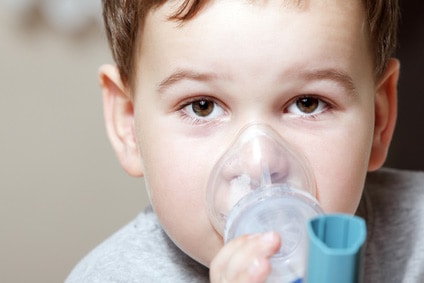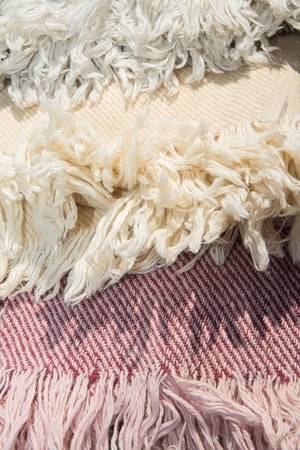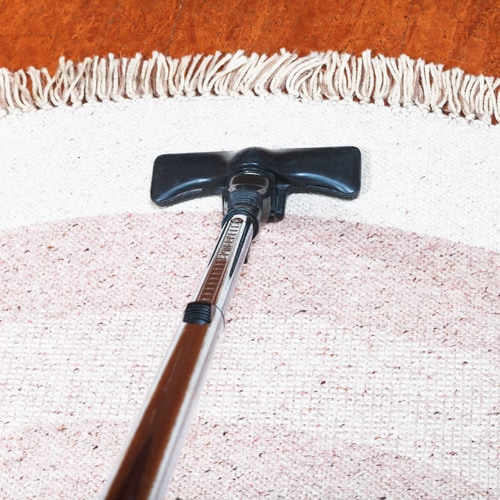
For your reference, here is some information regarding rug cleaning.
| Soil Level |
Vacuuming (times per week) |
Spot Cleaning |
Heavy-use Area Cleaning |
Restorative Cleaning |
|
Light Soil |
1 |
Daily, or when a spot is noticed |
Every 12-18 months |
Every 2 years (or as recommended by the manufacturer) |
|
Normal Soil (families with children, elderly) |
1-2 |
Daily, or when a spot is noticed |
Every 6-12 months |
Annually |
|
Heavy Soil (families with pets, smoking) |
2-4 |
Daily, or when a spot is noticed |
Every 3-6 months |
Semi-annually |
|
Extreme Conditions (multiple pets, large families) |
7 |
Daily, or when a spot is noticed |
Every 2-3 months |
Quarterly |
Besides having a professional rug cleaner clean your rug annually, semi-annually or quarterly (every 3 months) you should also vacuum it weekly and rotate it every 6 months to prolong its initial beauty and even the wear.
Why You Need to Clean Your Rug Regularly
Rug cleaning is paramount for a number of reasons, listed below:
- It helps increase the life of the rug significantly.
- Rugs trap airborne pollutant that have to be removed to protect both the indoor air quality and the rug itself.
- Most rug soils are dry. When you keep your area rug thoroughly vacuumed regularly the majority of dry soils are removed. Hence, the rug is maintained much easier.
- Rug cleaning removes stains and spots, which can attract more soiling, like any other soils.
- Most soiling of area rugs can lead to the buildup of unhealthy bacteria and allergens. Cleaning your carpets prevents these contaminants from becoming accumulated.
- A well-cleaned and well-maintained rug enhances the overall appearance of the room and speak volumes about the entire home’s (or facility’s) cleanliness.
- When a rug is within a workplace, keeping it clean is paramount to worker morale. Everybody likes working in a clean environment (the carpeting included).
- Regular cleaning helps remove bed bugs and dust mites that can be transported from the beds to practically every item in the household.
- Rug manufacturers require that rugs be cleaned annually, using the extraction method to maintain their warranty.
Pet Owners and Rug Cleaning

Using store-bought cleaners can damage your rug, and you may as well end up with a bleached rug with unattractive, uneven spots of cleaned rug, still smelling awful.
Besides odour, pet urine, feces, and vomit stains are permanent most of the times if they are left untreated for a while. Mind that all stripping and bleaching agents can cause significant damage to your rug’s fibers and any stain removal attempt should be done with extreme caution if you don’t want to make things worse.
Also, if a rug is exposed to repeated urine stains, you can expect it to start bleeding, meaning loose its colour (colour just washes away), due to the fact that pet urine stains turn from acidic to alkaline that cause significant damage to acid rug dyes. In addition, the cotton foundation fibers begin to become rotten with long-term exposure to pet urine, and this is something that cannot be reversed. The same applies to the cases where there are plants on top of the urine-stained rugs. The rugs slowly become rotten, leaving you with a rug with large holes. So, always inspect the back of the rug to spot any signs of dry rot (i.e. stiffness and/or dark mildew), especially if you have a pet that puddles in the same area of your rug repeatedly.
Tips for Pet Owners
- Own washable rugs. So, go for woven or even synthetic rather than tufted ones.
- It’s best to pick a busy design so the urine stains or any other won’t be too obvious. Professional rug cleaners will get your area rug cleaned, but the urine stains are most likely to remain (especially if left untreated for long).
- Use a pad under the rug to get protected protect from the worst case scenario. This is when the pet urine gets into your flooring (especially if you have hardwood floors) and creates a much larger issue that could result in replacing the floor.
Families with Small Children

To maintain a healthy environment for them to play, live, and grow up it is paramount to keep the rugs soil-free. That aside, it’s not only kids that soil the rugs. In a home full of people (and adults with hectic lives) rugs (especially those placed in the dining room) get dirty with all sorts of stains, such as wine, beverages, salad dressing, chocolate, mayonnaise, and food items. With such a plethora of dye stains, rug cleaning seems like never ending. Treating a stain upon its birth is the best thing to do to avoid resulting in a permanent stain. But, how easy is it to watch out for your children and make sure the stains are removed from the rugs effectively at the same time?
Health Risks Associated with Dirty Rugs
Rugs can pose considerable health risks if they are not cleaned regularly. A filthy rug is an entire universe of fungi, irritants, and microbes that can make you ill. Although harmless-looking on the surface, soiled rugs can cause:
- Respiratory Problems

Also, the mold that grows in filthy rugs can produce health-hazardous mycotoxins that turn the in-house air unhealthy. It has been evidenced that prolonged exposure to mycotoxins can result in adverse conditions such as hypersensitivity, among many others.
- Skin Infection
With a dirty carpet at home, you may experience skin redness, swelling, or itchiness, mainly due to the irritants (living and non-living) hoarded in the rug. If you also have pets like rats and roaches, it could get even more complicated as it is known that these house pets are attracted to the particles of a filthy rug’s fibers and carry their own germs. That way, the entire family is exposed to even more microbes that cause diseases.
That said, asthma is not always associated with respiratory problems. It can manifest itself as itchy rashes and is triggered by dust and dirt in a rug that has not been cleaned.
The athlete’s foot is another common skin condition related to dirty rugs and is extremely annoying. It is a contagious fungal infection that you can get if you walk barefoot on a rug that has been infested by fungi. Whatever breaks, scratches, or cuts in your skin give a safe passageway to fungi to enter your system and cause chronic itching.
- Allergies
As previously mentioned, pet hairs, dust, tiny insects, and fungi spores are the most common allergens found in a dirty rug. People with pre-existing allergies will experience uncomfortable allergic attacks the moment they are exposed to the allergens released into the air by walking on the filthy rig, which include sneezing, skin itchiness, and malaise.
- Increased Stress Levels
Studies have revealed that living in an unclean environment can increase one’s stress levels. Stress doesn’t cause immediate health problems, but too much of it can make you (and everybody living in the same household or workplace) more susceptible to disease, given that it weakens the immune system. Everybody knows that accumulated stress can cause heart strokes and attacks.
For all the reasons specified above, carpet cleaning should not be neglected and it is best if carried out by a professional rug cleaning service provider that can deal with all kinds of rug-related problems, at least annually, to ensure a clean and healthy home or other facility for you and your loved ones.




